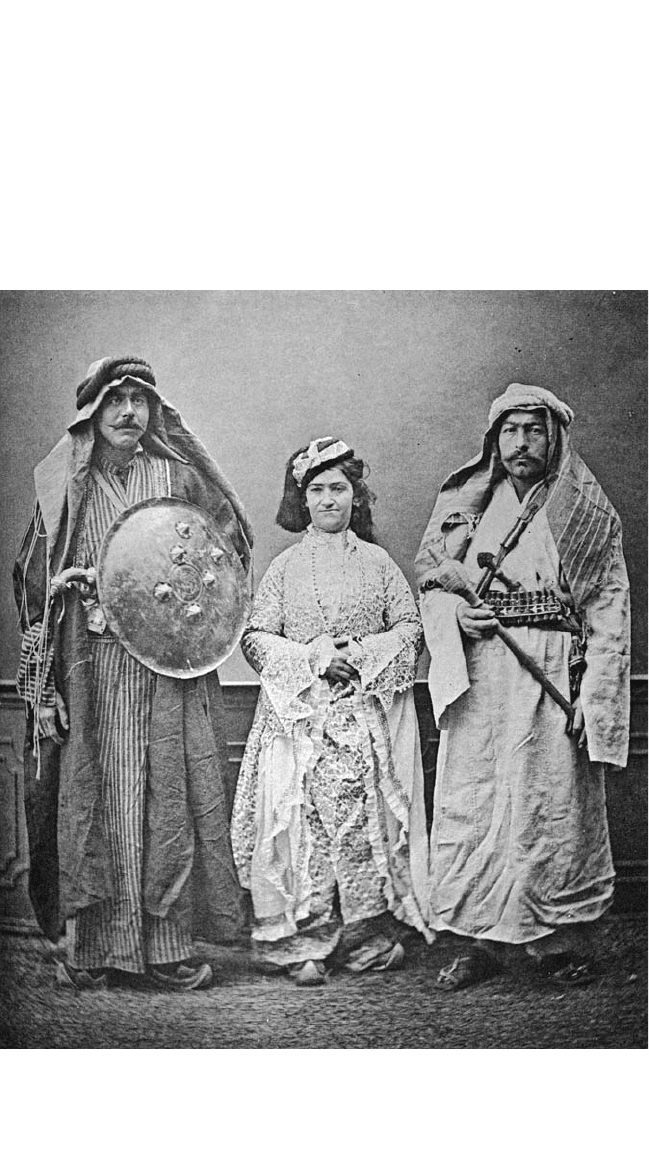Fattah H., Caso F. A Brief History Of Iraq
Подождите немного. Документ загружается.


A BRIEF HISTORY OF IRAQ
142
1830s, a combination of the plague, the fl ooding of the Tigris, and an
Ottoman army at the gates of Baghdad brought down the last of the
Mamluks, Dawud Pasha. A short time later, the Jalilis of Mosul were
also dislodged, as were the Babans of Shahrizor (ca. 1850). Henceforth,
Istanbul sent a steady stream of governors to reclaim the provinces of
Iraq. The history of the mid-19th century onward in Iraq is largely that
of the interaction between a centralizing state and a society still autono-
mous in its philosophy and traditions.
This period in Ottoman history is characterized by a series of
Western-infl uenced reforms, prompted by edicts called tanzimat (“reg-
ulations,” in Turkish) that were promulgated in 1839 and 1859. New
standing armies were raised; land laws went into effect reorganizing
land tenure, production, and revenue; a new administrative map was
created that reordered provinces on a more “effi cient” basis; and local
municipal governments were reorganized to include previously mar-
ginalized groups, such as Christians, Jews, and other minorities. It
has often been stated, somewhat incorrectly, that as a result of these
provisions, the provinces of the Ottoman Empire underwent a process
of rapid “modernization.” The Tanzimat era is generally seen as the
period in which reforms associated with European modernity were
adapted and applied, fi rst, to Istanbul and its surrounding region and,
later on, to both European and Arab provinces of the Ottoman Empire.
But, as many recent studies have shown, this so-called Westernization
was often only a gloss on ongoing, internal developments within the
empire itself. Much of the “new” thinking was not so much the result
of an overt application of European models but a continuous sifting of
different paradigms to reshape a state and society in the throes of an
internal transformation.
The Reform of the Army
The principal reform associated with the Tanzimat era was the reor-
ganization and reconstruction of the army. Internal transformation
had been the rallying cry of Ottoman reformers for quite some time.
Prior to the early 19th century, the Ottoman army consisted of impe-
rial troops, the bulk of which were Janissary regiments. The latter had
infi ltrated the trade and industry of Istanbul as well as the European
and Arab provinces, creating local alliances that often ran counter
to the wishes of the central government that they were supposed to
serve and obey. On a couple of occasions, the Janissaries had even
staged coups and dislodged the sultan himself. The Janissary threat

143
IMPERIAL ADMINISTRATION, LOCAL RULE, AND OTTOMAN RECENTRALIZATION
had become so great that their doom seemed almost foretold; when
Sultan Mahmud II extinguished them through wholesale slaughter,
he signaled the rise of a more centralized military force completely
under his command.
This new force, the Ottoman standing army, was trained and advised
by Westerners, who founded new military schools and pushed for
European arms, tactics, and strategy (Inalcik and Quataert 1994, 766).
While it took almost half a century to materialize, a tighter, leaner army
was established that went on to win several major battles in the early
phases of World War I.
In the provinces of Iraq, the army was reorganized, and new
military and civilian schools were established as a result; the latter’s
emphasis on languages and the hard sciences was somewhat of a radi-
cal departure from the traditional kuttab, or Islamic school, stress on
religious and literary subjects and rote learning. But here again, the
core principles of army discipline, effective training, and loyalty to
the corps took a long time to materialize. In the last quarter of the
19th century, the Sixth Army, based in Baghdad, was considered to be
one of the empire’s least successful military units (Longrigg 1953, 38)
simply because there was never enough money or matériel to hold it
together. Composed of two divisions of infantry, a cavalry division,
and artillery regiments, the army was made up of conscripts, many
of whom could buy their way out of service through a military “tax.”
Entire sectors of Iraqi society escaped the military in this way, while
those soldiers who remained were often unruly and spelled trouble
for the army command.
In 1910–11, however, a strong governor in Baghdad, Nazim Pasha
(1848–1912), who had also been named the commander of the army,
attempted to whip the army into shape. Nazim Pasha’s zeal in reforming
the Sixth Army awakened British alarm. His emphasis that no expense
be spared in this attempt to turn the ramshackle army into a fi ghting
force made him a competitor to watch. Meanwhile, the British consul
received disturbing reports of huge guns being brought in to revital-
ize Ottoman defenses and the daily and nightly training of troops. To
top it all off, Nazim Pasha embarked on furious campaigns against the
Iraqi tribes, creating much dissension in Baghdad, particularly since
he attempted to defeat the tribes in one fell swoop, strongly testing his
unprepared troops. Eventually, he was recalled to Istanbul because of
heavy British pressure. Still, Iraq’s Sixth Army performed very well in
World War I, infl icting a huge defeat on the British in Kut in 1916, only
to be routed at the end of the war.

A BRIEF HISTORY OF IRAQ
144
Local Government Councils, Schools,
New Printing Presses, and Newspapers
Prior to the mid-19th century, no local governing councils had existed
in Iraq outside the shaykh’s tent or the Ottoman governor’s palace.
After the Tanzimat edicts, an administrative council was established
for each provincial capital. Headed by the vali, or provincial governor,
it grouped appointed and elected members; for the fi rst time, the lat-
ter consisted of Christians and Jews. Side by side with administrative
reforms, civilian schools were created that taught a different curricu-
lum, including military training, and followed novel philosophies. By
introducing military training at an early stage and incorporating the
hard sciences, geography, and foreign languages in its curriculum, the
rushdiya (middle school) and idadiya (high school) school system in
Iraq opened up different avenues for its student population.
Under Midhat Pasha (r. 1869–71), the fi rst printing press was intro-
duced in Iraq. This made possible the fi rst state newspaper, al-Zawra,
Courtyard of the palace of the Ottoman governor of Baghdad in the late 19th century, dur-
ing the period when the Tanzimat edicts had gone into effect
(Library of Congress)

145
IMPERIAL ADMINISTRATION, LOCAL RULE, AND OTTOMAN RECENTRALIZATION
which was originally published in Ottoman Turkish but was later
turned into a bilingual edition. Among its many editors was the sober
Islamist intellectual Shaykh Mahmud Shukri al-Alusi (1857–1934),
whose great reputation as a reformist scholar endowed the newspaper
with a crusading ethos. Among his many editorials were those that
castigated late Ottoman authorities for neglecting Islamic places of
worship and pious foundations.
Forty years later, under less stringent censorship rules (brought
on by the Constitutional Revolution in Turkey in 1908), a number of
Iraqi as well as foreign-owned papers made their appearance. About
36 papers and magazines were published in Iraq by Iraqis before the
collapse of the Ottoman Empire in 1918. For example, the outstand-
ing weekly al-Riyadh began publication in 1910. Owned by Suleyman
al-Dakhil, who is considered to be the fi rst journalist-editor from Najd
(central Arabia) to own and publish a newspaper, it was put together
in Baghdad, due in no small part to the fact that Arabia and Iraq had
long been linked by cultural, economic, and social ties. Although it
only lasted four years, al-Riyadh published original and path-break-
ing reports on central Arabian tribes and dynasties and courted the
Ottomans by openly appealing to them to intervene against British
schemes in the Arabian Peninsula.
Al-Riyadh was only one of the many newspapers published at the
turn of the 20th century. Other Iraqi-owned newspapers of note were
al-Raqib, published by the crusading journalist Abdul-Latif Thunayan,
and Sada Babil, owned and operated by the Christian intellectuals
Dawud Sliwu and Yusif Ghanima. Echoes of those papers continue
today. For instance, al-Nahda was established by Ibrahim Hilmi Umar
and Muzahim Amin al-Pachachi in 1913. Al-Nahda lives on today
because al-Pachachi’s son, Dr. Adnan al-Pachachi, established a paper
under the same name in 2003. (It was one of the most sober and well-
researched papers published in Baghdad after 2003.)
The Land Law of 1858
Under the Ottomans, the area of south-central Iraq, known in Islamic
history as al-Sawad, had become the home of many displaced tribes of
Najdi origin, such as the Shammar and the Bani Lam, who had migrated
from Arabia to Iraq from as early as the 17th century. Throughout the
18th to the last part of the 19th centuries, Ottoman governors tried
several different strategies to tame the nomadic and semipastoralist
tribes. Because the usual tactics of attacking tribal camps and sup-

A BRIEF HISTORY OF IRAQ
146
pressing select tribal leaders proved to be short-lived policies, Ottoman
pashas and military commanders were eventually drawn to the strategy
of tribal settlement on collectively held tribal lands. The notion was
that sedentarization would produce stability, and stability would equal
peace and prosperity.
The story of reform is usually associated with the arrival in Baghdad
of the vali, or governor, Midhat Pasha in 1869. However, even earlier
reformist valis introduced, for example, river steamers in 1855 (preced-
Arabs from Baghdad Province in traditional clothing. The man on the left (with shield) is
wearing traditional Shammar clothing.
(Library of Congress)

147
IMPERIAL ADMINISTRATION, LOCAL RULE, AND OTTOMAN RECENTRALIZATION
ing those of British fi rms) and augmented the fl eet in 1869. Evidence
also suggests that governors had already begun reviewing and attempt-
ing to overhaul the land system in Iraq before Midhat’s arrival. With his
accession to power in Iraq, however, the review and overhaul began in
earnest.
Iraqi governments in Baghdad, Basra, and, to a lesser extent, Mosul
faced large problems with regard to the agricultural sector throughout
the 18th and early 19th centuries. First was the problem of the insta-
bility of revenue collection; although tribal lands were theoretically
administered for the collective benefi t of the tribe, the paramount
shaykh had wide latitude in the use and disbursement of agricultural
revenue. Throughout the period in question, tribal shaykhs were some-
times patronized by the state but more often warred upon. This was
because in order to secure revenue for the state, either the shaykh paid
out taxes willingly or was forced to do so through military coercion.
Because of the erratic nature of revenue collection, therefore, the state
never became truly solvent.
A second problem, alluded to earlier, was the fact that by the middle
of the 18th century, “whatever the formal title of the land—miri [state
lands], mulk [land privately owned], or waqf [endowments]—much of
it was in fact under private control [and] much of the miri-land was
treated as the private property of high offi cials or of members of infl u-
ential families” (Nieuwenhuis 1982, 112–113). Thus, the second factor
inhibiting the state’s economic well-being was the permanent alienation
of lands formally under state title. As a result of these two factors, both
of which undercut the state’s income, government reform of land tenure
and production became an urgent proposition.
Midhat Pasha’s fi rst act was “to replace the piecemeal policies of his
predecessors with a program of land registration and tax reform which,
he hoped, would increase production, encourage nomadic settlement,
raise revenues, and destroy the power of the tax farmers and tribal
sheikhs all in one go” (Owen 1981, 185). The goal of the Land Law,
promulgated in 1858 in Istanbul but applied only much later in Iraq,
was to secure the land for those who actually cultivated it, but the tribal
peasants for whom it was legislated attached no importance to private
property and the greater majority even suspected that land registration
schemes were a government ploy intended to list conscripts for the new
army. Many shaykhs and urban merchants were more perspicacious,
however, and registered formerly communal lands under their own
names; after Midhat’s departure in 1871, some sanads, or title deeds,
were even auctioned off to the paramount shaykh’s own family and

A BRIEF HISTORY OF IRAQ
148
allies (this happened in the Muntafi q districts of south-central Iraq),
reversing Midhat’s original intent to reward the cultivator and not his
patron with title deeds.
Land registration failed its original constituency because it was
undertaken with little cognizance of the facts on the ground; the idea
that lands were communally held yet subject to the infl uence of the
paramount shaykh was not something that had been anticipated in the
law. Moreover, as time went on, the whole registration scheme became
politicized; because registration brought with it economic power, the
local governments began to use it in ways to further their political
agendas. Thus, they awarded title deeds to tribal leaders who did their
bidding, and disenfranchised those with whom they had complaints.
Also, the drawing of new borders around tribal districts by administra-
tive fi at caused turmoil in the districts themselves; so many title deeds
were sloppily recorded that they became the cause for litigation later
on. But perhaps the most important development of the new reorder-
ing of land and property ownership in late 19th-century Iraq was the
rise of a new landed class of tribal shaykhs and urban merchants and
moneylenders. This last, loosely defi ned strata was to become the new
elite of the early 20th century, with whom the Ottomans and, later on,
the British had to deal and, more important, placate at various critical
junctures of the country’s history.
Trade and Transport: The British Dimension in Local Affairs
The Tanzimat reforms were not the only factors to reshape Iraq in the
19th century. By the 1830s, a number of developments, both internal
and external, had combined to radically affect Iraqi trade. In 1811–12,
the Ottoman-Egyptian army under Ibrahim Pasha, son of the viceroy
of Egypt, Muhammad Ali, had begun its Arabian campaign; eventually,
it was to defeat the remnants of the once powerful Saudi state that had
kept much of the Gulf, Arabia, and southern Iraq in its thrall. No lon-
ger threatened by the Saudi monopoly on regional trade, whether on
land or by sea, merchants from the area were able to jump back into
the fray, their networks revitalized, their prospects bright. In the early
1830s, however, the British had begun to make important inroads in
the Gulf region. After the 1821 truce with the local principalities on
the Arab side of the Gulf and their even more assured control of the sea
route to India, the British became the unchallenged masters of Indian
Ocean trade. Henceforth, regional merchants, whether Indian, Persian,
or Arab, had to tread softly with the new power in their region; as a

149
IMPERIAL ADMINISTRATION, LOCAL RULE, AND OTTOMAN RECENTRALIZATION
result of this new state of affairs, the more clever merchants made their
peace early with the British presence in Iraq and the Gulf and became
mediators between the latter and local society.
In Iraq proper, this meant that although foreign trade became the
chief monopoly of British ships and British-affi liated merchants, local
trade—the trade carried on in small boats on the twin rivers and camel
caravan in the interior—remained under local hands. This made for a
risky enterprise for the British. The British shipping company of Lynch
Bros., for example, fi nally introduced its two steamers on the Tigris
in 1862–65 but required the services of a soldier to make the journey
from Baghdad to Basra, and from there to Bombay, in complete secu-
rity. Still, a small but gradual increase in Iraq’s seaborne trade to India
occurred at that time, and Iraqi goods—dates, wheat, barley, and even
live horses—were transported in greater numbers to India and Europe.
It was only with the opening of the Suez Canal in 1869, however, that
there was an exponential growth in Iraqi trade. From 1870 to 1880, for
instance, the value of exports rose from £206,000 to £1,275,000 (Owen
1981, 182).
Between 1900 and 1913, Britain accounted for nearly half of Iraq’s
imports and a quarter of its exports (Owen 1981, 276). Based on the
tonnage of ships alone, it was also by far the most important shipping
power in the Gulf and Indian Ocean, reaching 137,000 tons a year,
whereas local craft only carried 12,500 tons. Finally, it is calculated that
in 1913, 163 British steamers arrived yearly in Iraq (Owen 1981, 276).
This raft of fi gures would be impressive on its own were it not for the
fact that British supremacy was not only based on commercial power
but on military infl uence as well. By 1914, at the start of World War I,
Britain was the most important naval power in the world, a fact under-
lined in the Gulf and Iraq by its unstated supremacy on these shores.
The Shii Shrine Cities of Iraq Revisited
At the beginning of the 19th century, the Shii shrine cities of Najaf,
Karbala, and Kadhimain continued under the spiritual infl uence of reli-
gious scholars, the maraji al-taqlid (marja al-taqlid, sing., “the source
of emulation”; a religious leader of such erudition that individual Shiis
follows his teachings), or the mujtahids (Islamic legal authorities). But
beginning in or around the 1780s, changes had occurred in Najaf and
Karbala that brought external infl uence to bear on the cities’ social,
economic, and political composition. The fi rst had to do with what has
been called the remission of “Indian money” to the shrines, especially

A BRIEF HISTORY OF IRAQ
150
those in Najaf and Karbala. Briefl y, the Oudh Bequest, set up by the
Shiis ruler of Awadh (Oudh) in British-controlled India, channeled
close to £10,000 a year to the leading Shii clergy in Iraq. Spent on badly
needed infrastructural projects, such as canal building and irrigation
works, as well as for money contributions to the leading mujtahids,
the bequest cemented ties between Najaf, Karbala, and northern India.
After the British annexation of Awadh in 1856, when the bequest
began to be distributed by the British agent in Baghdad on behalf of
the nawab of Awadh, it further shored up ties between the shrine cities
and the British. However, because of the complicated situation of the
Shii cities, in which autonomy movements were played out against the
background of imperial Ottoman centralizing rule and rival Persian and
Indian infl uences, little concrete change was affected between the Shii
leadership and British economic and political interests in Iraq.
The second change occurred with the imposition of a more central-
ized administration in Karbala. Up to the early 20th century, all of the
shrine cities of Iraq were in theory administered by Ottoman governors
and tax collectors and kept in check by Ottoman troops. By the 1820s
and 1830s, however, the localization of power had affected more than
the religious clergy; it had brought about the emergence of a class
within a class of merchants and city “bosses” who had usurped power
from the older landholding families and begun to control the city’s
wards. This “mafi a” (to use Juan Cole’s terminology) consisted of youth
gangs, small merchants, and laborers, with the occasional vagabond
journeyman or thief thrown in.
The unique status of Karbala, with its self-governing hierarchy of
clergy, landholders, and urban gang leaders, irked the Ottomans. After
repeated military feints against the city, which had become dangerously
independent in Ottoman eyes, the governor of Baghdad, Najib Pasha,
sent an army to conquer Karbala and bring it back within the Ottoman
fold. In January 1842, the die was cast. Breaching a strategic wall of
the city, the Ottoman army attacked. After a fi erce fi ght in which more
than 5,000 of Karbala’s forces were killed while only 400 government
soldiers lost their lives, the Ottoman troops succeeded in reining in the
local elements and conquering the town and its environs. On January
18, Najib Pasha entered Karbala and made straight for the sanctu-
ary of Imam Husayn, where he and his military commanders prayed
and gave thanks. After that, the governor spelled out the dimensions
of Karbala’s defeat: A Sunni governor was appointed over Karbala,
Sunni judges were sent to the city to administer the court system, and
a Sunni preacher was brought in to lead the Friday prayers, at which

151
IMPERIAL ADMINISTRATION, LOCAL RULE, AND OTTOMAN RECENTRALIZATION
the Ottoman sultan’s name would be ritually mentioned as a symbol of
dominion (Cole 2002, 118).
While Karbala’s fi re was extinguished and its spirit broken, the struc-
ture of Ottoman power remained a facade. By the early 20th century,
all the city’s powerbrokers—the local mob leaders, smaller clergy, and
merchants—had returned to assume their places in the great game of
autonomous rule versus renewed imperialism in the context of late
Ottoman Iraq.
Conclusion
By the turn of the 20th century, the Iraqi provinces had become more
closely linked under late Ottoman rule. While the greater incorpora-
tion of the provinces into a more tightly centralized and demarcated
region brought with it closer identifi cation with the notion of “Iraq”
as a common homeland, the country’s population was not uniformly
Ottomanized as a corollary of that identifi cation. Certain elites emerged
that recognized their affi liation with the greater empire, but they did
so on a vastly different basis than before. The starting point for the
reinforced ties between the provinces and the center was now based
on a revised interpretation of what it meant to be an Ottoman citizen.
No longer seen as subjects but as full-fl edged members in a pluralis-
tic Islamic empire, some Iraqis took up a wider Ottoman affi liation
because it promised a fairer deal between equal citizens in the greater
Ottoman realm. The ideology of Ottoman citizenship also tied in to the
greater representation of national, ethnic, and religious minorities in
the empire, particularly Christians and Jews, a factor that initially may
have inhibited the wholesale adoption of an “Osmanli” nationality by
its Arab-Muslim adherents.
Although reformist valis had successfully begun to implement ideas
that would radically restructure the provinces, those ideas required
time to fall into place. Even so, several reforms had begun to impact
the country in the latter years of Ottoman rule. First were the military
reforms that reorganized the Sixth Army and made it a competent
fi ghting force capable not only of defending the country but of instigat-
ing well-planned offensives in wartime. Second, military and civilian
schools had begun to cut into the huge illiteracy rate; the most prom-
ising military cadets were given scholarships to join the military and
administrative colleges in Istanbul. Many of them returned as avowed
Turkophiles. Third, with the introduction of the fi rst offi cial newspaper
in Iraq, al-Zawra in 1869, the fl oodgates of newspaper and magazine
